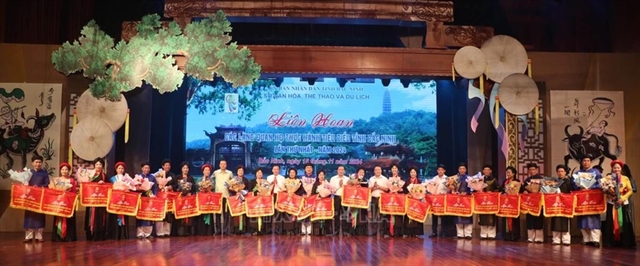 |
| At the first-ever Quan họ village festival. — VNA/VNS Photo |
BẮC NINH — More than 700 singers from 24 quan họ (love duet) singing villages in the northern province of Bắc Ninh on November 15 gathered at the first-ever quan họ village festival, an event held to mark the 15th anniversary of the UNESCO’s recognition of the folk singing as an intangible cultural heritage element of humanity.
They honoured the heritage through traditional unaccompanied duets, solo performances, and group singing.
The festival aimed at evaluating the villages’ contributions to preserving the folk songs over the recent past while creating an opportunity for local singers to meet and exchange experiences in practising the heritage in the community.
According to Deputy Director of the provincial Department of Culture, Sports and Tourism Nguyễn Xuân Trung, quan họ has evolved beyond its traditional village boundaries to become a vibrant force in the community's spiritual and economic life.
The art form has transformed from village performances to diverse stages, reaching audiences both domestically and internationally.
Originally, quan họ singing was only found on the southern bank of the Cầu River in Bắc Ninh Province. However, due to its significant influence, it spreads to neighbouring areas on the northern bank of the Cầu river in Bắc Giang Province. The Cầu River is also known as the quan họ river.
There are opinions suggesting that quan họ dates back to the 11th century, while others believe it originated in the 17th century. All of them emphasise the significant value of the intangible cultural heritage of quan họ. This art form is considered the core of the culture of the Kinh Bắc region, with a history of thousands of years of civilisation.
Compared to other forms of folk singing such as hát xoan, hát ghẹo, hát ca trù, hát ví dặm, tuồng, and cải lương, quan họ singing has existed the longest, with a lifespan of thousands of years.
Quan họ is a form of folk singing characterised by a duet format. The male singers, known as liền anh, wear traditional attire of folded scarves and the, shirts, while the female singers, known as liền chị, don elegant dresses and round hats made from palm leaves with long silk straps. They sing together in pairs, delivering simple and soulful verses in a traditional style that does not require musical accompaniment yet remains melodious.
Most quan họ songs follow the verse form of lục bát or its variations, and there are also songs in prose form. Up to now, at least 300 melodies of quan họ have been notated, consisting of verses and poems, primarily in the lục bát form, passed down by quan họ artists to collectors.
Quan họ was recognised by UNESCO as an intangible cultural heritage element of humanity in 2009.
Every year, as spring arrives, people from quan họ villages in the Kinh Bắc region, including both Bắc Ninh and Bắc Giang provinces, return to their hometowns to join various local festivals, such as temple and pagoda ones. These festivals are incredibly unique because they have been closely associated with the tradition of quan họ singing for generations. — VNA/VNS


